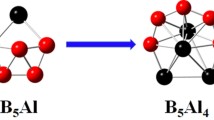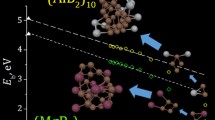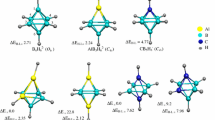Abstract
Neutral, anionic, and cationic B3Al 0/−/+n (n = 2–6) clusters were systematically explored using density functional theory and coupled cluster CCSD(T) methods to investigate the structural evolution of small mixed aluminum–boron clusters. The lowest energy structures of these clusters were obtained using an unbiased global minimum search, and their structural growth behaviors are discussed. The three boron atoms in B3Al 0/−/+n preferentially form a stable triangle, with additional Al atoms occupying the periphery of the boron triangle. For small clusters of n ≤ 3, the studied clusters show planar two–dimensional configurations. When n ≥ 4, the clusters prefer three–dimensional configurations. Average binding energies, fragmentation energies, second–order differences, HOMO–LUMO gaps, ionization potentials and electron affinities are discussed in detail. For cationic B3Al +n (n = 2–6) clusters, the even n systems are more stable than the odd n systems, while the stabilities of neutral B3Aln and anionic B3Al −n clusters do not change significantly with growing n. The infrared spectrum and photoelectron spectroscopy of these clusters are simulated, which will be useful for future experimental research. We also compare the chemical bonding of neutral B3Aln (n = 2–6) clusters with their ionic clusters by AdNDP analysis.
Graphic Abstract














Similar content being viewed by others
References
X. Li, H. Wu, X.-B. Wang, and L.-S. Wang (1998). S-P hybridization and electron shell structures in aluminum clusters: A photoelectron spectroscopy study. Phys. Rev. Lett. 81, (9), 1909.
A. P. Sergeeva, I. A. Popov, Z. A. Piazza, W.-L. Li, C. Romanescu, L.-S. Wang, and A. I. Boldyrev (2014). Understanding boron through size-selected clusters: structure, chemical bonding, and fluxionality. Acc. Chem. Res. 47, (4), 1349–1358.
M. T. Huynh and A. N. Alexandrova (2011). Persistent covalency and planarity in the BnAl 2−6−n and LiBnAl −6−n (n = 0–6) cluster ions. J. Phys. Chem. Lett. 2, (16), 2046–2051.
M. Boyukata and Z. B. Guvenc (2011). Density functional study of AlBn clusters for n = 1–14. J. Alloys Compd. 509, (11), 4214–4234.
X. Feng and Y. Luo (2007). Structure and stability of Al-doped boron clusters by the density-functional theory. J. Phys. Chem. A 111, (12), 2420–2425.
Z.-Y. Jiang, X.-M. Luo, S.-T. Li, and S.-Y. Chu (2006). Structures and stability of B-doped Al anions: AlnB− and AlnB2− (n = 1–7). Int. J. Mass Spectrom. 252, (3), 197–203.
Z.-Y. Jiang, C.-J. Yang, and S.-T. Li (2005). Structures and stability of B-doped Al clusters: AlnB and AlnB2 (n = 1–7). J. Chem. Phys. 123, (20), 204315.
J. Gu, C. Wang, Y. Cheng, L. Zhang, X. Yang (2014) Probing the structural and electronic properties of boron cluster anions doped with one or two aluminum atoms. Comput. Theor. Chem. 67–74.
D. T. T. Mai, H. T. Pham, N. M. Tam, and M. T. Nguyen (2019). Geometry and bonding of small binary boron–aluminum clusters BnAln (n = 1–7): Electron donation and interlocking aromaticity. Chem. Phys. Lett. 714, 87–93.
C. Romanescu, A. P. Sergeeva, W.-L. Li, A. I. Boldyrev, and L.-S. Wang (2011). Planarization of B7− and B12− clusters by isoelectronic substitution: AlB6− and AlB11−. J. Am. Chem. Soc. 133, (22), 8646–8653.
W.-L. Li, C. Romanescu, T. R. Galeev, L.-S. Wang, and A. I. Boldyrev (2011). Aluminum avoids the central position in AlB9− and AlB10−: Photoelectron spectroscopy and ab Initio study. J. Phys. Chem. A 115, (38), 10391–10397.
T. R. Galeev, C. Romanescu, W.-L. Li, L.-S. Wang, and A. I. Boldyrev (2011). Valence isoelectronic substitution in the B8− and B9− molecular wheels by an Al dopant atom: Umbrella-like structures of AlB7− and AlB8−. J. Chem. Phys. 135, (10), 104301.
B. Song, Y. Zhou, H.-M. Yang, J.-H. Liao, L.-M. Yang, X.-B. Yang, and E. Ganz (2019). Two-Dimensional Anti-Van’t Hoff/Le Bel Array AlB6 with High Stability, Unique Motif, Triple Dirac Cones, and Superconductivity. J. Am. Chem. Soc. 141, (8), 3630–3640.
A. P. Sergeeva, B. B. Averkiev, H. J. Zhai, A. I. Boldyrev, and L. S. Wang (2011). All–boron analogues of aromatic hydrocarbons: B17− and B18. J. Chem. Phys. 134, (22), 224304.
A. D. Becke (1993). Density-functional thermochemistry. III. The role of exact exchange. J. Chem. Phys. 98, (7), 5648–5652.
C. Lee, W. T. Yang, and R. G. Parr (1988). Development of the Colle-Salvetti correlation–energy formula into a functional of the electron density. Phys. Rev. B 37, (2), 785–789.
J. S. Binkley, J. A. Pople, and W. J. Hehre (1980). Self-consistent molecular orbital methods. 21. Small split-valence basis sets for first-row elements. J. Am. Chem. Soc. 102, (3), 939–947.
M. S. Gordon, J. S. Binkley, J. A. Pople, W. J. Pietro, and W. J. Hehre (1982). Self-consistent molecular-orbital methods. 22. Small split-valence basis sets for second-row elements. J. Am. Chem. Soc. 104, (10), 2797–2803.
G. D. Purvis and R. J. Bartlett (1982). A full coupled-cluster singles and doubles model: The inclusion of disconnected triples. J. Chem. Phys. 76, (4), 1910–1918.
D. Y. Zubarev and A. I. Boldyrev (2008). Developing paradigms of chemical bonding: adaptive natural density partitioning. Phys. Chem. Chem. Phys. 10, (34), 5207–5217.
M. J. Frisch, G. W. Trucks, H. B. Schlegel, G. E. Scuseria, M. A. Robb, J. R. Cheeseman, G. Scalmani, V. Barone, B. Mennucci, G. A. Petersson, H. Nakatsuji, M. Caricato, X. Li, H. P. Hratchian, A. F. Izmaylov, J. Bloino, G. Zheng, J. L. Sonnenberg, M. Hada, M. Ehara, K. Toyota, R. Fukuda, J. Hasegawa, M. Ishida, T. Nakajima, Y. Honda, O. Kitao, H. Nakai, T. Vreven, J. A. Montgomery, J. E. Peralta, F. Ogliaro, M. Bearpark, J. J. Heyd, E. Brothers, K. N. Kudin, V. N. Staroverov, T. Keith, R. Kobayashi, J. Normand, K. Raghavachari, A. Rendell, J. C. Burant, S. S. Iyengar, J. Tomasi, M. Cossi, N. Rega, J. M. Millam, M. Klene, J. E Knox,. J. B. Cross, V. Bakken, C. Adamo, J. Jaramillo, R. Gomperts, R. E. Stratmann, O. Yazyev, A. J. Austin, R. Cammi, C. Pomelli, J. W. Ochterski, R. L. Martin, K. Morokuma, V. G. Zakrzewski, G. A. Voth, P. Salvador, J. J. Dannenberg, S. Dapprich, A. D. Daniels, O. Farkas, J. B. Foresman, J. V. Cioslowski (2013) Gaussian 09, Revision D. 01; Gaussian, Inc. Wallingford, CT.
T. Lu and F. W. Chen (2012). Multiwfn: a multifunctional wavefunction analyzer. J. Comput. Chem. 33, (5), 580–592.
P. Pyykkö (2014). Additive covalent radii for single-, double-, and triple-bonded molecules and tetrahedrally bonded crystals: a summary. J. Phys. Chem. A. 119, (11), 2326–2337.
Acknowledgements
L. M. W, D. Z, and L.–M. Y. gratefully acknowledge support from the National Natural Science Foundation of China (21673087, 21873032, 21903032, 22073033), startup fund (2006013118 and 3004013105) from Huazhong University of Science and Technology, and the Fundamental Research Funds for the Central Universities (2019kfyRCPY116). The authors thank the Minnesota Supercomputing Institute (MSI) at the University of Minnesota for supercomputing resources. The work was carried out at LvLiang Cloud Computing Center of China, and the calculations were performed on TianHe-2.
Author information
Authors and Affiliations
Corresponding authors
Ethics declarations
Conflicts of interest
There are no conflicts of interest to declare.
Additional information
Publisher's Note
Springer Nature remains neutral with regard to jurisdictional claims in published maps and institutional affiliations.
Electronic supplementary material
Below is the link to the electronic supplementary material.
Rights and permissions
About this article
Cite this article
Wen, L., Zhou, D., Yang, LM. et al. Atomistic Structures, Stabilities, Electronic Properties, and Chemical Bonding of Boron–Aluminum Mixed Clusters B3Al 0/−/+n (n = 2–6). J Clust Sci 32, 1261–1276 (2021). https://doi.org/10.1007/s10876-020-01884-7
Received:
Accepted:
Published:
Issue Date:
DOI: https://doi.org/10.1007/s10876-020-01884-7




